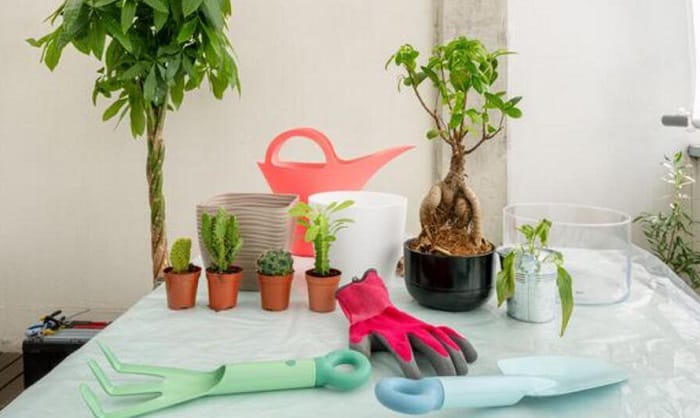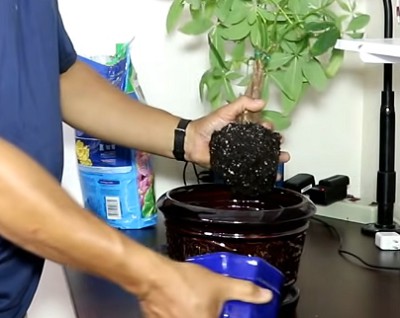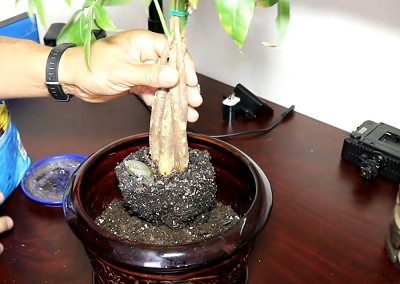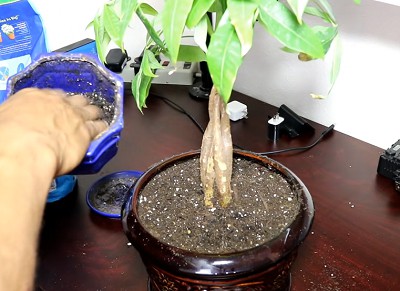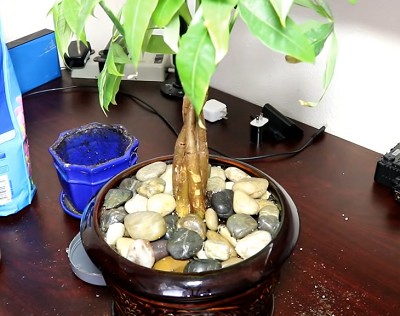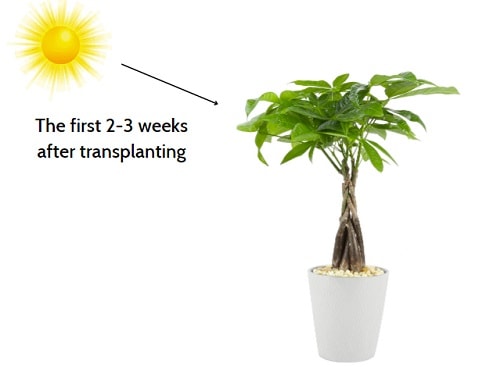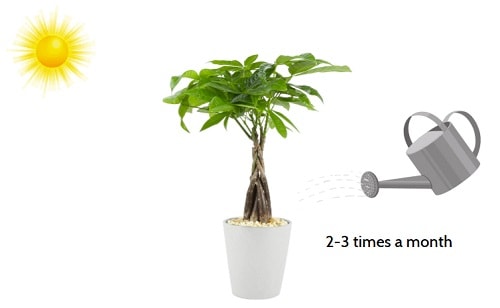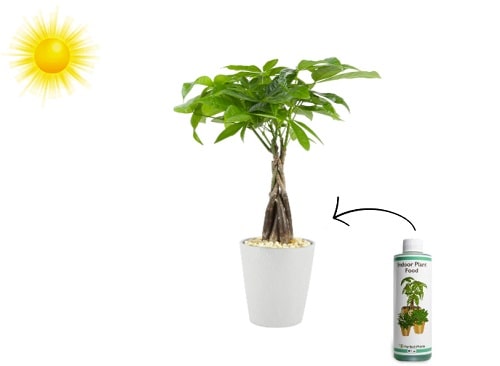Anyone who has seen money plants will recognize them, thanks to their distinctive braided trunks.
Given that these plants symbolize wealth and fortune, it’s common for money trees to function as gifts, especially among business partners and friends. In fact, it’s not unusual for people to buy money trees as Lunar New Year presents, considering their low maintenance demands.
If you have these ornamentals in your house and notice their roots sticking out of the container, it’s time to learn how to repot a money tree plant.
Doing so will allow it to grow bigger and absorb nutrients better. Plus, you’ll have a fancy ornament to display, which is a fantastic thing, whether you believe in feng shui or not.
Table of Contents
3 Steps to Repot a Money Tree Plant
1. Preparation
Before repotting money plant, you should prepare the following:
- A pot 1 to 2 inches bigger than your current one — This money tree pot size will allow your plant to spread and lower chances of root rot due to soggy soil.
- Knife
- Rubbing alcohol
- Newspaper/tarp
- Water
- Tray — This one is optional; you can use it to catch the excess liquid from the pot while watering. Otherwise, placing the pot over a sink should work.
- Peat moss, perlite, and coarse sand — These will form your potting mix.
A day or two before transplanting, I recommend watering the plant thoroughly. This step will reduce transplant shock and give you a healthier money tree to start with.
At the same time, check your new container and ensure it has at least one drainage hole. If you feel the hole is so big that it prevents water from soaking in, lay plastic mesh or landscape fabric liner over the gap. Styrofoam and packing peanuts will do the job as well.
It doesn’t matter much what pot material you use, though there are some considerations to keep in mind.
For humid homes or owners prone to overwatering, clay or terracotta is ideal.
Meanwhile, plastic pots will suit households with rambunctious kids and people who want something with moderate water retention. These containers release water more slowly than clay or terracotta but as quickly as ceramic, making them suitable for owners who irrigate less frequently.
2. Remove the plant from its container.
Before repotting a money tree, you must remove it from its current container.
Lay a newspaper or tarp on your table to prevent water and soil drippings from dirtying your furniture.
Afterward, hold the bottom of the plant with one hand and upend the container with the other. If your money tree is too entrenched in the pot, gently poke the soil edge with a knife to loosen it.
Once you’ve got the plant out, check for parts with root rot and trim them off. The rotten sections will often feel mushy, look brown, and emanate a foul odor. If the roots are curled or have formed circles, pry them apart with your hands to eliminate tangles.
Most importantly, sanitize your knife before trimming. Soak the tool in a mixture of 70% rubbing alcohol and water for five minutes, with both components making up half of the solution.
3. Put the plant in a new container.
Grab the new plant container and put in it equal parts of peat moss, perlite, and sand. Pour in enough to fill an inch of the pot, then place the root ball of the money tree in the pot’s middle.
Continue adding the plant mix until the roots sit high enough that only one inch comes between them and the container’s edge.
Remove some of the peat moss/perlite/sand combo if there is too little space at the top of the container; otherwise, water will flow out every time you irrigate.
Once the positioning is perfect, lightly press the planting mix and water it until liquid drips from the drain hole.
That’s it! You’ve finished replanting a money tree.
Best Time to Repot a Money Tree Plant
When to repot money tree? Spring and summer are the best seasons for doing so. Money trees resume growing during these periods, and if you give them new, fertile soil with sufficient sunlight, they will become taller and larger.
Moreover, the plant’s active state allows it to adapt quickly to new containers, reducing problems stemming from environmental changes.
The only time winter repotting is fine is when your money tree is bogged down by disease and the current soil is no longer amendable.
Take Care of Money Trees After Repotting
To minimize the risks of money tree transplant shock, follow our tips below:
- Keep the tree under indirect sunlight next to a south-facing window. This is the ideal brightness level for money trees, and it’s vital that you satisfy this requirement, especially during the first two to three weeks after transplanting.
- Water money tree after repotting two or three times a month. You can stick your finger into the pot first to check. If the top two to four inches are dry, irrigating is fine. Each time, provide enough moisture so that liquid comes out of the drain hole.
- Spritz the plant with lukewarm water every day and fertilize it with liquid plant food once a month, when the money tree is not going through its dormancy. Perfect Plants sell a product you can mix with water before applying.
- Care for a money tree by checking for aphids, mealy bugs, scale, and spider mites. Once you see these pests, washing the foliage with dish soap and insecticidal soap should help remove them.
FAQs
What is a money tree plant?
Money tree, or Pachira aquatica, is an ornamental plant that originates from central and south America. This plant produces nuts that are unfit for human consumption, and are largely used as decoration due to its striking yellow flowers and palmate leaves.
Why is repotting money trees important?
Naturally, there will come a time when these plants become too large for their present containers.
Moreover, money tree potting soil often declines in quality after about a year, and you may notice it becoming too firm or containing no organic matter.
There’s also the matter of pest infestation to think of. As careful as you may be, it’s tough, if not impossible, to eliminate all bugs from unhealthy soil, particularly when they’ve grown eggs. The only surefire way to save money trees from disease is to give them new, sanitized containers and soil.
How often do money trees need repotting?
Chinese money plant repotting should take place every two to three years. However, trees grow at different rates depending on how you care for them, so relying on the following indicators may prove more useful:
- The roots are coming out of the pot base or the top of the soil.
- Lack of growth despite healthy soil conditions.
- The plant lacks vibrancy and tends to tip over.
- The soil doesn’t retain moisture well.
What kind of potting soil does a money tree need?
You can use the soil for money tree we described in the tutorial section. It has the attributes these plants prefer, which are peat-based and well-drained.
As for a commercial potting mix for money plant, look for pre-mixed cactus soil. Sand, pumice, perlite, and vermiculite are excellent ingredients to have and should bring the best results.
In the meantime, here are some other alternatives you can try to DIY your potting medium:
- Coco coir, compost, and perlite or vermiculite in a 1:1:1 ratio
- ¾ Coco coir, ⅛ charcoal, and just as much organic compost
- Equal parts of coco coir and pumice with compost
Does money tree like to be root bound?
No, money trees do not enjoy being root-bound. As obvious as it may sound, bigger trees require more soil, and confining your plant to a pot it’s outgrown means there won’t be enough micronutrients and water to meet its demands.
The result will be wavy leaves on your money trees instead of the regular flat ones. You can expect plant height to stagnate as well.
Conclusion
How to repot a money tree plant? All you have to do is slide the plant from its container, clean and trim the roots of disease, then insert it into a sandy, well-drained potting mix.
As long as you follow our care tips, your money tree should adapt to its new environment and begin thriving like it used to. Just remember not to fertilize the plant during the first month of repotting.
Read more tips to repot other plants:

Hi, I am William – Floridayards’ digital content creator. My job is to find answers to all your concerns with thorough research and our team’s expert advice. I will also bring you honest reviews on the best products and equipment for raising your beautiful garden. Please look forward to our work!



